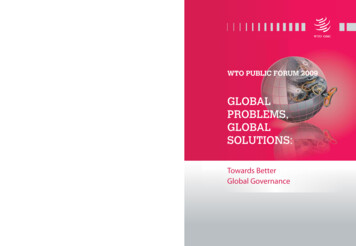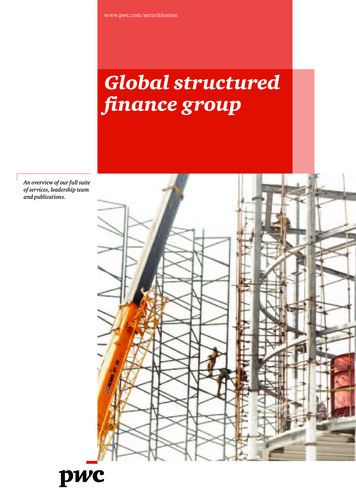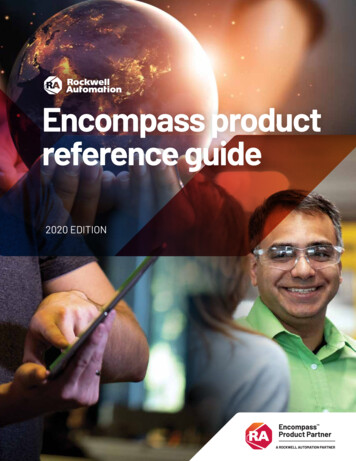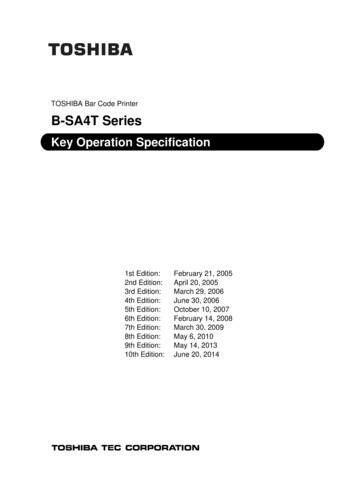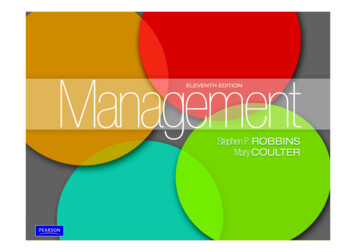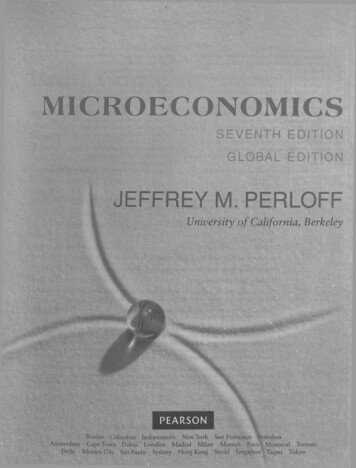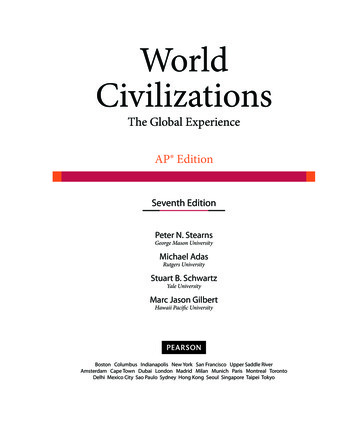
Transcription
WorldCivilizationsThe Global ExperienceAP EditionSeventh EditionPeter N. StearnsGeorge Mason UniversityMichael AdasRutgers UniversityStuart B. SchwartzYale UniversityMarc Jason GilbertHawaii Pacific UniversityBoston Columbus Indianapolis New York San Francisco Upper Saddle RiverAmsterdam Cape Town Dubai London Madrid Milan Munich Paris Montreal TorontoDelhi Mexico City Sao Paulo Sydney Hong Kong Seoul Singapore Taipei TokyoA01 STEA7705 07 SE FM.indd 119/11/13 8:02 PM
Editor-in-Chief: Dickson MusslewhitePublisher: Charlyce Jones OwenProject Manager: Rob DeGeorgeProgram Manager: Seanna BreenEditorial Assistant: Maureen DianaSenior Operations Supervisor: Mary Ann GloriandeSenior Art Director: Maria LangeInterior Design: Red Kite ConsultingCover Design: Depinho DesignManager, Visual Research & Permissions: Beth BrenzelCover photo credit: Werner Forman/Art Resource, NY—Threewomen with fireworks. India. Moghul. ca. 1640.Media Director: Brian HylandMedia Editor: Elizabeth Roden HallComposition/Full-Service Project Management: SPi Global/Bruce HobartPrinter/Binder: Courier/KendallvilleCover Printer: Lehigh-Phoenix Color/HagerstownThis book was set in 10/12 Minion ProCredits and acknowledgments borrowed from other sources and reproduced, with permission, in this textbook appear on page C-1.Copyright 2015, 2011, 2007 Pearson Education, Inc., publishing as Prentice Hall, 1 Lake St., Upper Saddle River, NJ 07458. Allrights reserved. Manufactured in the United States of America. This publication is protected by Copyright, and permission shouldbe obtained from the publisher prior to any prohibited reproduction, storage in a retrieval system, or transmission in any form orby any means, electronic, mechanical, photocopying, recording, or likewise. To obtain permission(s) to use material from this work,please submit a written request to Pearson Education, Inc., Permissions Department, One Lake Street, Upper Saddle River, NJ 07458.Many of the designations by manufacturers and seller to distinguish their products are claimed as trademarks. Where those designations appear in this book, and the publisher was aware of a trademark claim, the designations have been printed in initial caps or all caps.AP is a trademark registered and/or owned by the College Board, which was not involved in the production of, and does not endorse, this product.Library of Congress Cataloging-in-Publication Data on file10 9 8 7 6 5 4 3 2 1Student Edition: High School BindingISBN 10: 0-13-344770-7ISBN 13: 978-0-13344770-5PearsonSchool.com/AdvancedA01 STEA7705 07 SE FM.indd 219/11/13 8:02 PM
Brief ContentsPART IEarly Human Societies, 2.5 million–600 b.c.e.: Origins and Development 11 From Human Prehistory to the EarlyCivilizations 714 The Spread of Chinese Civilization: Japan, Korea,and Vietnam 30815 The Last Great Nomadic Challenges: FromChinggis Khan to Timur 33116 The World in 1450: Changing Balance of WorldPower 3512 Early Civilizations, 3500–600 b.c.e. 21PART IIThe Classical Period, 600 b.c.e.–600 c.e. 483 Classical Civilization: China 544 Classical Civilization: India 745 Classical Civilizations in the Middle East andMediterranean 946 The Classical Period: Directions, Diversities, andDeclines by 500 c.e. 117PART IIIThe Postclassical Period, 600–1450: NewFaith and New Commerce 1497 The First Global Civilization: The Rise and Spreadof Islam 156PART IVThe Early Modern Period, 1450–1750:The World Shrinks 37717181920The World Economy 384The Transformation of the West, 1450–1750 405Early Latin America 425Africa and the Africans in the Age of the AtlanticSlave Trade 45321 The Rise of Russia 47822 The Muslim Empires 49323 Asian Transitions in an Age of GlobalChange 520PART V8 Abbasid Decline and the Spread of IslamicThe Dawn of the Industrial Age,1750–1900 5549 African Civilizations and the Spread of24 The Emergence of Industrial Society in the West,Civilization to South and Southeast Asia 182Islam 2041750–1900 56110 Civilization in Eastern Europe: Byzantium25 Industrialization and Imperialism: The Making11 A New Civilization Emerges in Western26 The Consolidation of Latin America,12 The Americas on the Eve of Invasion 26513 Reunification and Renaissance in Chinese27 Civilizations in Crisis: The Ottoman Empire,and Orthodox Europe 224Europe 241Civilization: The Era of the Tang and SongDynasties 287of the European Global Order 5871810–1920 612the Islamic Heartlands, and Qing China 63928 Russia and Japan: Industrialization Outsidethe West 662iii A01 STEA7705 07 SE FM.indd 319/11/13 8:02 PM
PART VI33 Latin America: Revolution and Reaction intothe 21st Century 821The Newest Stage of World History:1900–Present 69334 Africa, the Middle East, and Asia in the Era of29 Descent into the Abyss: World War I and the Crisis35 Rebirth and Revolution: Nation-Building in Eastof the European Global Order 70130 The World between the Wars: Revolutions,Depression, and Authoritarian Response 72931 A Second Global Conflict and the End of theEuropean World Order 765Independence 843Asia and the Pacific Rim 86936 Power, Politics, and Conflict in World History,1990–2014 89737 Globalization and Resistance 91832 Western Society and Eastern Europe in theDecades of the Cold War 791ivBrief ContentsA01 STEA7705 07 SE FM.indd 419/11/13 8:02 PM
ContentsFeatures xPrefacePart IIxivSupplementary Teaching and Learning Materials xxAbout the AuthorsxxiiTeacher to Teacher xxiiiCorrelation of World Civilizations to the AP CourseOutline for World History xxivPrologue xxxiiPart IEarly Human Societies, 2.5 million–600 b.c.e.: Origins and D evelopment 1Chapter 1 From Human Prehistory to the EarlyCivilizations 7Getting Started Is Always Hard 9Human Development and Change 10The Neolithic Revolution 12Agriculture and Change 15Nomadic Societies 16Global Connections and Critical Themes: The EarlyCivilizations and the World 20Further Readings 20Critical Thinking Questions 20Chapter 2 Early Civilizations, 3500–600 b.c.e. 21Civilization 22Tigris-Euphrates Civilization 23Egyptian Civilization 27Egypt and Mesopotamia Compared 29River Valley Civilization in India 30China 32Early Civilizations in the Americas 33The End of the River Valley Period 35Global Connections and Critical Themes: The EarlyCivilizations and the World 38Further Readings 38Critical Thinking Questions 39Part I AP Test Prep 40The Classical Period, 600 b.c.e.–600 c.e.: Uniting Large Regions 48Chapter 3 Classical Civilization: China 54Patterns in Classical China 56Political Institutions 60Religion and Culture 63Economy and Society 67A Distinctive Mixture 71Global Connections and Critical Themes: Classical Chinaand the World 72Further Readings 72Critical Thinking Questions 73Chapter 4 Classical Civilization: India 74The Framework For Indian History: Geographyand Culture 76Patterns in Classical India 78Political Institutions 80Religion and Culture 82Economy and Society 87Indian Influence and Comparative Features 88Global Connections and Critical Themes: India and theWider World 92Further Readings 93Critical Thinking Questions 93Chapter 5 Classical Civilizations in the Middle Eastand Mediterranean 94The Persian Tradition 97Patterns of Greek History 99Patterns of Roman History 101Greek and Roman Political Institutions 103Religion and Culture 107Economy and Society in the Mediterranean 111Toward the Fall of Rome 114Global Connections and Critical Themes: Persia,Greece, Rome, and the World 115Further Readings 116Critical Thinking Questions 116v A01 STEA7705 07 SE FM.indd 519/11/13 8:02 PM
Chapter 6 The Classical Period: Directions, Diversities,and Declines by 500 c.e. 117Beyond the Classical Civilizations 118Decline in China and India 125The Decline and Fall of the Roman Empire 129The Development and Spread of World Religions 133Global Connections and Critical Themes: The Late ClassicalPeriod and the World 137Further Readings 138Critical Thinking Questions 138Part II AP Test Prep 139Part IIIThe Postclassical Period, 600–1450:New Faith and New Commerce 149Chapter 7 The First Global Civilization: The Rise andSpread of Islam 156Desert and Town: The Harsh Environment of the Pre-IslamicArabian World 158The Life of Muhammad and the Genesis of Islam 163The Arab Empire of the Umayyads 166From Arab to Islamic Empire: The Early Abbasid Era 174Global Connections and Critical Themes: Early Islam and theWorld 180Further Readings 180Critical Thinking Questions 181Chapter 8 Abbasid Decline and the Spread of Islamic Civilization to South and Southeast Asia 182The Islamic Heartlands in the Middle and Late AbbasidEras 184An Age of Learning and Artistic Refinements 189The Coming of Islam to South Asia 192The Spread of Islam to Southeast Asia 200Global Connections and Critical Themes: Islam: A BridgeBetween Worlds 202Further Readings 202Critical Thinking Questions 203Chapter 9 African Civilizations and the Spreadof Islam 204African Societies: Diversity and Similarities 205Kingdoms of the Grasslands 209The Swahili Coast of East Africa 215Peoples of the Forest and Plains 217Global Connections and Critical Themes: InternalDevelopment and Global Contacts 222Further Readings 223Critical Thinking Questions 223viChapter 10 Civilization in Eastern Europe: Byzantium andOrthodox Europe 224Civilization in Eastern Europe 225The Byzantine Empire 227The Split Between Eastern and Western Christianity 231The Spread of Civilization in Eastern Europe 235The Emergence of Kievan Rus’ 235Global Connections and Critical Themes: Eastern Europeand the World 240Further Readings 240Critical Thinking Questions 240Chapter 11 A New Civilization Emerges in Western Europe 241Stages of Postclassical Development 243Western Culture in the Postclassical Era 253Changing Economic and Social Forms in thePostclassical Centuries 257The Decline of the Medieval Synthesis 260Global Connections and Critical Themes: Medieval Europeand the World 263Further Readings 263Critical Thinking Questions 264Chapter 12 The Americas on the Eve of Invasion 265Postclassic Mesoamerica, 1000–1500 c.e. 267Aztec Society in Transition 272Twantinsuyu: World of the Incas 276The Other Peoples of the Americas 282Global Connections: The Americas and the World 285Further Readings 285Critical Thinking Questions 286Chapter 13 Reunification and Renaissance in Chinese Civilization: The Era of the Tang andSong Dynasties 287Rebuilding the Imperial Edifice in the Sui-Tang Era 288Tang Decline and the Rise of the Song 295Tang and Song Prosperity: The Basis of a Golden Age 299Global Connections and Critical Themes: China’s WorldRole 307Further Readings 307Critical Thinking Questions 307Chapter 14 The Spread of Chinese Civilization: Japan,Korea, and Vietnam 308Japan: The Imperial Age 310The Era of Warrior Dominance 314Korea: Between China and Japan 319Between China and Southeast Asia: The Makingof Vietnam 322Global Connections and Critical Themes: In the Orbit ofChina: The East Asian Corner of the Global System 329Contents A01 STEA7705 07 SE FM.indd 619/11/13 8:02 PM
Further Readings 329Critical Thinking Questions 330Chapter 15 The Last Great Nomadic Challenges: FromChinggis Khan to Timur 331The Transcontinental Empire of Chinggis Khan 333The Mongol Drive to the West 339The Mongol Interlude in Chinese History 343Global Connections and Critical Themes: The MongolLinkages 349Further Readings 349Critical Thinking Questions 350Chapter 16 The World in 1450: Changing Balance ofWorld Power 351Key Changes in the Middle East 353The Structure of Transregional Trade 354The Rise of the West 356Outside the World Network 362Global Connections and Critical Themes: 1450 and theWorld 365Further Readings 366Critical Thinking Questions 366Part III AP Test Prep 367Part IVThe Early Modern Period, 1450–1750:The World Shrinks 377Chapter 17 The World Economy 384The West’s First Outreach: Maritime Power 385The Columbian Exchange of Disease and Food 391Toward A World Economy 393Colonial Expansion 396Global Connections and Critical Themes: The WorldEconomy—and the World 403Further Readings 403Critical Questions 404Chapter 18 The Transformation of the West, 1450–1750 405The First Big Changes: Culture and Commerce,1450–1650 407The Commercial Revolution 412The Scientific Revolution: The Next Phase of Change 415Political Change 417The West by 1750 420Global Connections and Critical Themes: Europe and theWorld 424Further Readings 424Critical Thinking Questions 424Chapter 19 Early Latin America 425Spaniards and Portuguese: From Reconquest toConquest 427The Destruction and Transformation of IndigenousSocieties 435Colonial Economies and Governments 436Brazil: The First Plantation Colony 441Multiracial Societies 443The 18th-Century Reforms 446Global Connections and Critical Themes: Latin AmericanCivilization and the World Context 451Further Readings 451Critical Thinking Questions 452Chapter 20 Africa and the Africans in the Age of the Atlantic Slave Trade 453Africa and the Creation of an Atlantic System 454The Atlantic Slave Trade 456African Societies, Slavery, and the Slave Trade 460White Settlers and Africans in Southern Africa 467The African Diaspora 469Global Connections and Critical Themes: Africa and theAfrican Diaspora in World Context 476Further Readings 476Critical Thinking Questions 477Chapter 21 The Rise of Russia 478Russia’s Expansionist Politics under the Tsars 479Russia’s First Westernization, 1690–1790 483Themes in Early Modern Russian History 489Global Connections and Critical Themes: Russia and theWorld 492Further Readings 492Critical Thinking Questions 492Chapter 22 The Muslim Empires 493The Ottomans: From Frontier Warriors to EmpireBuilders 495The Shi’a Challenge of the Safavids 504The Mughals and the Apex of Muslim Civilization inIndia 510Global Connections and Critical Themes: GunpowderEmpires and the Restoration of the Islamic Bridge amongCivilizations 518Further Readings 518Critical Thinking Questions 519Chapter 23 Asian Transitions in an Age of Global Change 520The Asian Trading World and the Coming of the Europeans 522Ming China: A Global Mission Refused 529Fending Off the West: Japan’s Reunification and theFirst Challenge 538Contents A01 STEA7705 07 SE FM.indd 7vii 19/11/13 8:02 PM
Global Connections and Critical Themes: An Age of EurasianProto-Globalization 542Further Readings 542Critical Thinking Questions 543Part IV AP Test Prep 544Part VThe Dawn of the Industrial Age,1750–1900 554Chapter 24 The Emergence of Industrial Society in theWest, 1750–1900 561Context for Revolution 562The Age of Revolution 564The Industrial Revolution: First Phases 569The Consolidation of the Industrial Order, 1850–1900 571Cultural Transformations 576Western Settler Societies 579Diplomatic Tensions and World War I 583Global Connections and Critical Themes: Industrial Europeand the World 585Further Readings 585Critical Thinking Questions 586Chapter 25 Industrialization and Imperialism:The Making of the European Global Order 587The Shift to Land Empires in Asia 590Industrial Rivalries and the Partition of the World,1870–1914 597Patterns of Dominance: Continuity and Change 601Global Connections and Critical Themes: A EuropeanDominated Early Phase of Globalization 610Further Readings 610Critical Thinking Questions 611Chapter 26 The Consolidation of Latin America,1810–1920 612From Colonies to Nations 614New Nations Confront Old and New Problems 618Latin American Economies and World Markets,1820–1870 620Societies in search of themselves 628Global Connections and Critical Themes: New LatinAmerican Nations and the World 637Further Readings 637Critical Thinking Questions 638Chapter 27 Civilizations in Crisis: The Ottoman Empire,the Islamic Heartlands, and Qing China 639From Empire to Nation: Ottoman Retreat and the Birthof Turkey 641Western Intrusions and the Crisis in the Arab IslamicHeartlands 644viiiThe Rise and Fall of the Qing Dynasty 650Global Connections and Critical Themes: Muslim andChinese Retreat and a Shifting Global Balance 660Further Readings 660Critical Thinking Questions 661Chapter 28 Russia and Japan: Industrialization outsidethe West 662Russia’s Reforms and Industrial Advance 664Protest and Revolution in Russia 670Japan: Transformation without Revolution 673Global Connections and Critical Themes: Russia and Japan inthe World 681Further Readings 682Critical Thinking Questions 682Part V AP Test Prep 683Part VIThe Newest Stage of World History:1900–Present 693Chapter 29 Descent into the Abyss: World War I andthe C risis of the European Global Order 701The Coming of the Great War 704A World at War 706Failed Peace and Global Turmoil 713The Nationalist Assault on the European Colonial Order 714Global Connections and Critical Themes: World War andGlobal Upheavals 727Further Readings 727Critical Thinking Questions 728Chapter 30 The World between the Wars: Revolutions,Depression, and Authoritarian Response 729The Roaring Twenties 730Revolution: The First Waves 736The Global Great Depression 748The Nazi Response 751Authoritarianism and New Militarism in Key Regions 753Global Connections and Critical Themes: EconomicDepression, Authoritarian Response, and DemocraticRetreat 762Further Readings 762Critical Thinking Questions 764Chapter 31 A Second Global Conflict and the End of theEuropean World Order 765Old and New Causes of a Second World War 767Unchecked Aggression and the Coming of War in Europeand the Pacific 770The Conduct of a Second Global War 772War’s End and the Emergence of the Superpower Standoff inthe Cold War 780Contents A01 STEA7705 07 SE FM.indd 819/11/13 8:02 PM
Nationalism and Decolonization in South and Southeast Asiaand Africa 781Global Connections and Critical Themes: Persisting Trendsin a World Transformed by War 789Further Readings 789Critical Thinking Questions 790Chapter 32 Western Society and Eastern Europe in theDecades of the Cold War 791After World War II: A New International Setting for theWest 793The Resurgence of Western Europe 796Cold War Allies: The United States, Canada, Australia, andNew Zealand 802Culture and Society in the West 804Eastern Europe After World War II: A Soviet Empire 809Soviet Culture: Promoting New Beliefs and Institutions 812Global Connections and Critical Themes: The Cold War andthe World 819Further Readings 819Critical Thinking Questions 820Chapter 33 Latin America: Revolution and Reaction into the21st Century 821Latin America After World War II 823Radical Options in the 1950s 825The Search for Reform and the Military Option 831Societies in Search of Change 837Global Connections and Critical Themes: Struggling Towardthe Future in a Global Economy 841Further Readings 842Critical Thinking Questions 842Chapter 34 Africa, the Middle East, and Asia in the Era ofIndependence 843The Challenges of Independence 845Postcolonial Options for Achieving Economic Growthand Social Justice 856Delayed Revolutions: Religious Revivalism and LiberationMovements in Settler Societies 862Global Connections and Critical Themes: PostcolonialNations in the Cold War World Order 867Further Readings 868Critical Thinking Questions 868Chapter 35 Rebirth and Revolution: Nation-Building inEast Asia and the Pacific Rim 869East Asia in the Postwar Settlements 871The Pacific Rim: More Japans? 877Mao’s China: Vanguard of World Revolution 882Colonialism and Revolution in Vietnam 889Global Connections and Critical Themes: East Asia and thePacific Rim in the Contemporary World 894Further Readings 895Critical Thinking Questions 896Chapter 36 Power, Politics, and Conflict in World History,1990–2014 897The End of the Cold War 898The Spread of Democracy 906The Great Powers and New Disputes 908The United States as Sole Superpower 911Global Connections and Critical Themes: New GlobalStandards, New Divisions 915Further Readings 916Critical Thinking Questions 917Chapter 37 Globalization and Resistance 918Global Industrialization 919Globalization: Causes and Processes 922The Global Environment 929Resistance and Alternatives 932Toward the Future 936Global Connections and Critical Themes: Civilizations andGlobal Forces 937Further Readings 937Critical Thinking Questions 938Part VI AP Test Prep 939CreditsIndexC-1I-1Contents A01 STEA7705 07 SE FM.indd 9ix 19/11/13 8:02 PM
FeaturesMaps1.1 The Spread of Human Populations, c. 10,000 b.c.e. 121.2 The Spread of Agriculture 142.1 Early Sumer 232.2 Mesopotamia in Maps 262.3 Egypt, Kush, and Axum, Successive Dynasties 282.4 India in the Age of Harappa and the Early Aryan Migrations 312.5 China in the Shang and Zhou Eras 333.1 The Era of Nomadic Incursions and Warring States 573.2 China from the Later Zhou Era to the Han Era 603.3 Ancient Capitals 694.1 India at the Time of Ashoka 794.2 The Gupta Empire 804.3 The Spread of Buddhism in Asia, 400 b.c.e.–600 c.e. 854.4 Eurasian and African Trading Goods and Routes, c. 300 b.c.e.to 300 c.e. 915.1 The Persian Empire in Its Main Stages 975.2 Greece and Greek Colonies of the World, c. 431 b.c.e. 995.3 Alexander’s Empire and the Hellenistic World,c. 323 b.c.e. 1005.4 The Expansion of the Roman Republic, 133 b.c.e. 1026.1 Trade Routes at the End of the Classical Era 1216.2 Civilizations of Central and South America 1236.3 Germanic Kingdoms after the Invasions 1316.4 The Mediterranean, Middle East, Europe, and North Africa,c. 500 c.e.1326.5 Major Religions of the Modern World 1367.1 Arabia and Surrounding Areas Before and During the Timeof Muhammad 1597.2 The Expansion of Islamic Civilization, 622–750 1687.3 Emergence of the Abbasid Dynasty 1748.1 The Abbasid Empire at Its Peak 1858.2 The Spread of Islam, 10th–16th Centuries 1918.3 Early Islam in India 1948.4 The Spread of Islam in Southeast Asia 2019.1 Empires of the Western Sudan 2109.2 The Swahili Coast; African Monsoon Routes and MajorTrade Routes 21610.1 The Byzantine Empire under Justinian 22810.2 The Byzantine Empire, 1000–1100 23310.3 East European Kingdoms and Slavic Expansion c.1000 23611.1 Charlemagne’s Empire and Successor States 24611.2 Western Europe toward the End of the Middle Ages,c. 1360 c.e. 25011.3 Leading Trade Routes Within Western and Central Europe and to the Mediterranean 25712.1 Central Mexico and Lake Texcoco 26912.2 Inca Expansion 27612.3 The Ancient Cities of Peru 27813.1 China During the Age of Division 28913.2 The Sui Dynasty and the Tang Dynasty 29013.3 China in the Song and Southern Song Dynastic Periods 29714.1 Key Centers of Civilization in East Asia in the First Millennium c.e. 30914.2 Japan in the Imperial and Warlord Periods 31114.3 The Korean Peninsula During the Three Kingdoms Era 32014.4 South China and Vietnam on the Eve of the Han Conquest 32315.1 The Transcontinental Empire of Chinggis Khan 33215.2 The Four Khanates of the Divided Mongol Empire 34015.3 The Mongol Empire and the Global Exchange Network 34216.1 Polynesian Expansion 36317.1 Spain and Portugal: Explorations and Colonies 38817.2 French, British, and Dutch Holdings, c. 1700 39118.1 Western Europe During the Renaissance and Reformation 41018.2 Europe under Absolute Monarchy, 1715 41218.3 European Population Density, c. 1600 41419.1 Major Spanish Expeditions of Conquest in and fromthe Caribbean Region 429x A01 STEA7705 07 SE FM.indd 1019/11/13 8:02 PM
19.2 Colonial Brazil 43030.2 Eastern Europe and the Soviet Union, 1919–1939 73519.3 Spanish and Portuguese South America around 1800 44830.3 China in the Era of Revolution and Civil War 74620.1 Portuguese Contact and Penetration of Africa 45630.4 The Expansion of Japan to the Outbreak of World War II 75821.1 Russian Expansion under the Early Tsars, 1462–1598 48131.1 World War II in Europe and the Middle East 77321.2 Russia under Peter the Great 48431.2 Asia and the Pacific in World War II 77721.3 Russia’s Holdings by 1800 48831.3 The Partition of Palestine After World War II 78822.1 The Ottoman, Safavid, and Mughal Empires 49632.1 Soviet and Eastern European Boundaries by 1948 79422.2 The Expansion of the Ottoman Empire 49732.2 Germany After World War II 79522.3 The Safavid Empire 50432.3 The European Union 79922.4 The Growth of the Mughal Empire, from Akbar to Aurangzeb 51033.1 U.S. Military Interventions, 1898–2000 83623.1 Routes and Major Products Exchanged in the Asian Trading Network, c. 1500 52334.1 The Emergence of New Nations in Africa afterWorld War II 84723.2 The Pattern of Early European Expansion in Asia 52734.2 The Partition of South Asia: The Formation of India, Pakistan, Bangladesh, and Sri Lanka 84823.3 Ming China and the Zheng He Expeditions, 1405–1433 53434.3 The New West African Nations 85623.4 Japan During the Rise of the Tokugawa Shogunate 53934.4 The Middle East in the Cold War Era 85924.1 Napoleon’s Empire in 1812 56735.1 The Pacific Rim Area by 1960 87124.2 Industrialization in Europe, c. 1850 57135.2 China in the Years of Japanese Occupation and Civil War, 1931–1949 88224.3 The Unification of Italy 57424.4 The Unification of Germany, 1815–1871 57524.5 Early 19th-Century Settlement in the United States, Canada, Australia, and New Zealand 58224.6 The Balkans After the Regional Wars, 1913 58425.1 European Colonial Territories, Before and After 1800 59025.2 The Stages of Dutch Expansion in Java 59125.3 The Growth of the British Empire in India, from the 1750sto 1858 59335.3 Vietnam: Divisions in the Nguyen and French Periods 88935.4 North and South Vietnam 89136.1 Post–Soviet Union Russia, Eastern Europe, and Central Asiaby 1991 90436.2 The Implosion of Yugoslavia, 1991–2008 90936.3 Main U.S. Overseas Military Installations by 2007 91537.1 Multinational Corporations in 2000 92425.4 The Partition of Africa Between c. 1870 and 1914 59925.5 The Partition of Southeast Asia and the Pacificto 1914 60026.1 Independent States of Latin America in 1830 61827.1 British Egypt and the Anglo-Egyptian Sudan 64927.2 Ottoman Empire from Late 18th Century toWorld War I 65127.3 Qing Empire from Opium War of 1839–1841 toWorld War I 652DocumentsAryan Poetry in Praise of a War Horse 17Hammurabi’s Law Code 26Teachings of the Rival Chinese Schools 66A Guardian’s Farewell Speech to a Young Woman About toBe Married 83Rome and a Values Crisis 11327.4 Coastal China and Its Hinterland in the 19th Century 655The Popularization of Buddhism 12728.1 Russian Expansion, 1815–1914 666The Thousand and One Nights as a Mirror of Elite Society inthe Abbasid Era 17828.2 The Russo-Japanese War 67228.3 Japanese Colonial Expansion to 1914 68029.1 World War I Fronts in Europe and the Middle East 70429.2 Africa During World War I 71029.3 The Middle East after World War I 72030.1 From Dominions to Nationhood: Formation of Canada,Australia, and New Zealand 734Ibn Khaldun on the Rise and Decline of Empires 188The Great Oral Tradition and the Epic of Sundiata 212Russia Turns to Christianity 237European Travel: A Monk Visits Jerusalem 250Aztec Women and Men 274Ties That Bind: Paths to Power 293Features A01 STEA7705 07 SE FM.indd 11xi 19/11/13 8:02 PM
Literature as a Mirror of the Exchanges among Asian Centersof Civilization 328Women and Power in Byzantium 229A European Assessment of the Virtues and Vices ofthe Mongols 337Archeological Evidence of Political Practices 277Bubonic Plague 358Western Conquerors: Tactics and Motives 398Controversies About Women 421A Vision from the Vanquished 433An African’s Description of the Middle Passage 471The Nature of Westernization 485An Islamic Traveler Laments the Muslims’ Indifferenceto Europe 503Exam Questions as a Mirror of Chinese Values 531Protesting the Industrial Revolution 573Contrary Images: The Colonizer versus the Colonized on the“Civilizing Mission” 602Confronting the Hispanic Heritage: From Independenceto Consolidation 625Transforming Imperial China into a Nation 659Conditions for Factory Workers in Russia’s Industrialization 668Lessons for the Colonized from the Slaughter inthe Trenches 715Peasant Labor 245Footbinding as a Marker of Male Dominance 303What Their Portraits Tell Us: Gatekeeper Elites and the P ersistenceof Civilizations 326The Mongol Empire as a Bridge Between Civilizations 342Population Trends 357West Indian Slaveholding 394Versailles 417Race or Culture? A Changing Society 444The Cloth of Kings in an Atlantic Perspective 473Oppressed Peasants 490Art as a Window into the Past: Paintings and History in MughalIndia 513The Great Ships of the Ming Expeditions That Crossedthe Indian Ocean 536The French Revolution in Cartoons 566Capitalism and Colonialism 605Images of the Spanish-American War 634Mapping the Decline of Two Great Empires 651Two Faces of Western Influence 678Socialist Realism 759Trench Warfare 708Japan’s Defeat in a Global War 778Guernica and the Images of War 754A Cold War Speech 817National Leaders for a New Global Order 784The People Speak 830Women at Work in France and the United States 806Cultural Creativity in the Emerging Nations: Some LiterarySamples 852Murals and Posters: Art and Revolution 827Globalization and Postcolonial Societies 866Women in the Revolutionary Struggles for Social Justice 887Pacific Rim Growth 880Democratic Protest and Repression in China 907Symbolism in the Breakdown of the Soviet Bloc 905Protests against Globalization 927Two Faces of Globalization 935Visualizing the PastRepresentations of Women in Early Art 11Mesopotamia in Maps 25Capital Designs and Patterns of Political Power 68The Pattern of Trade in the Ancient Eurasian World 91Political Rituals in Persia 110Religious Geography 136The Mos
Correlation of World Civilizations to the AP Course Outline for World History xxiv Prologue xxxii Part I EARLY HUMAN SOCIETIES, 2.5 MILLION– 600 b.c.e.: ORIGINS AND DEvELOPMENT 1 ChAPTER 1 From Human Prehistory to the Early Civilizations 7 9 10 The Neolithic Revolution 12 15 16 Civilizati

